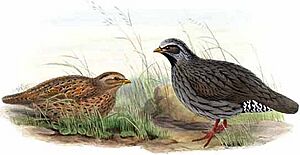Himalayan quail facts for kids
Quick facts for kids Himalayan quail |
|
|---|---|
 |
|
| Painting by John Gould based on specimens in the Derby museum (now World Museum) (male and female on 1 April 1836 in Nainital). These are the type specimens (D259 and D259a). | |
| Conservation status | |
| Scientific classification | |
| Genus: |
Ophrysia
|
| Species: |
superciliosa
|
 |
|
| Synonyms | |
|
Rollulus superciliosus |
|
The Himalayan quail (scientific name: Ophrysia superciliosa), also called the mountain quail, is a medium-sized bird from the pheasant family. It's a type of quail. This bird was last seen in 1876 and many people worry it might be extinct.
Scientists only know about this species from 12 birds found in just two places. These places are in the western Himalayas in Uttarakhand, north-west India. The last time someone officially saw a Himalayan quail was in 1876. This sighting was near the hill town of Mussoorie.
Contents
What Does the Himalayan Quail Look Like?
This small, dark quail is easy to spot because of its bright red beak and legs. It also has white spots above and below its eyes. The male quail is dark grey with faint stripes. It has a white forehead and a white stripe above its eye, called a supercilium.
The female quail is brownish with dark stripes and greyish eyebrows. Like the male, she has a white spot in front of her eye. She also has a bigger white spot behind her eye.
Scientists believe these quails only fly if someone scares them from very close by. They were usually found in small groups of five or six birds. Their home was on steep hillsides covered with long grass. The name Ophrysia comes from a word meaning "brow," which refers to the white stripe above their eye.
This quail has long feathers covering its tail. Its tail has 10 feathers and is quite long, almost as long as its wing. This is longer than the tails of most other quails. The feathers on its forehead are stiff and bristly.
First Discoveries and Specimens
The Himalayan quail was first described in 1846 by John Edward Gray. He studied live birds that were part of the collection of the Earl of Derby at Knowsley Hall. Gray noted that the birds came from "India."
The two original birds Gray studied are now kept at the World Museum in National Museums Liverpool. Their special numbers are D259 (male) and D259a (female). These birds were bought in India near Mussoorie in 1836. They became part of the Liverpool collection when the 13th Earl of Derby gave his collection to the city.
The first time the quail was found in the wild was in 1865. Kenneth Mackinnon shot a pair in November in a valley behind Mussoorie. This was at a height of about 1,800 meters (6,000 feet). Two years later, in November, five more birds were found near Jerepani (Jharipani). In December 1876, Major G. Carwithen found another bird near Nainital. This was at a height of about 2,100 meters (7,000 feet).
Frank Finn thought the bird might migrate, meaning it moved to different places during the year. However, he wasn't sure because its wings were short. People who saw the birds near Mussoorie said they lived in small groups of six to ten. They stayed hidden in tall grass and bushes. They ate grass seeds and were hard to make fly. When they did fly, they made a sharp whistling sound. They seemed to arrive around November but sometimes stayed until June before disappearing.
Where the Quail Lived
All records of the Himalayan quail show they lived at heights between 1,650 and 2,400 meters (about 5,400 to 7,900 feet). They were found in areas with tall grass and bushes on steep hillsides. They especially liked the tops of slopes that faced south or east.
It's thought they might have had their babies around September. One young male bird found in June was changing its feathers. Allan Octavian Hume suggested that the Himalayan quail acted like the Manipur bush quail. This means it was rarely seen except early in the morning or late in the evening. It stayed hidden in tall grass and preferred to run away rather than fly when scared.
The soft, fluffy feathers of the quail suggest it was made for cold weather. Some people think the birds moved to higher mountains in the summer. However, their wings don't seem built for long flights. The places where they were found are almost 200 kilometers (124 miles) apart. These places are separated by the lower Ganges valley near Rishikesh. This distance suggests the birds might have moved short distances between seasons. They might have had a continuous breeding area but separate places for winter.
Why is the Himalayan Quail So Rare?
The Himalayan quail has not been seen for sure in the wild since 1876. The places where these birds used to live have changed a lot because of human activities. The current habitats in these areas might not be suitable for them anymore.
A study in 2015 looked at how quickly species go extinct. It suggested that the Himalayan quail might still exist. The study also looked at the habitat of another bird, the monal. Based on this, it suggested there might be some places around Mussoorie where scientists could search very carefully for the quail.
Images for kids
-
"Eyebrowed Rollulus" - A drawing from life by Edward Lear in J E Gray's Gleanings from the Menagerie and Aviary at Knowsley Hall (1846). These are the type specimens D259 and D259a in the collections at World Museum.




